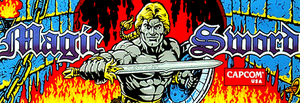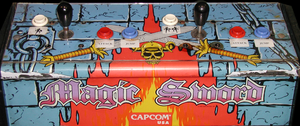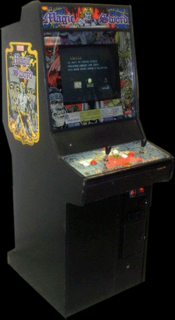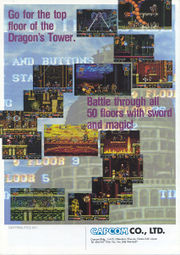Lost In Translation/Magic Sword - Heroic Fantasy
| Magic Sword Heroic Fantasy | |
|---|---|
| Manufacturer | Capcom |
| Released | 1990 |
| Control Method |
8-way Joystick 2 Button(s) |
| Main CPU | 68000 (@ 10.000 MHz) Z80 (@ 3.580 MHz) |
| Sound CPU | Mono YM2151 (@ 3.580 MHz) OKI6295 (@ 1.000 MHz) |
| Video Details |
Raster (Horizontal) 384 x 224 pixels 60.00 Hz 4,096 Palette colours |
| Screens | 1 |
| ROM Info | 12 ROMs 3,473,408 bytes (3.31 MiB) |
| MAME ID | msword · mswordj · mswordr1 · mswordu |
About The Game
Magic Sword - Heroic Fantasy is an arcade video game.
The land has been cast in darkness by Drokmar, who has been corrupted by the Black Orb; an artifact that promises immortality to anyone who comes under the influence of the orb's powerful sorcery. Two warriors set out to fight their way through fifty levels of platform beat-em-up, in order to destroy the orb - which lies at the top of the Dragon Tower - and free their lands.
Treasure chests litter the levels which, when smashed open, release treasure items, magic power-ups, keys, food and weapons. As players fight their way through the levels, they will come across a number of trapped prisoners. As long as the heroes are carrying keys, prisoners can be released who will then fight alongside the players, with each prisoner possessing their own unique attacks. Weapons and power-ups can be picked up to aid players in their quest and food can be found and eaten to increase player health.
As the players ascend the tower, they will be granted new magical weapons after each boss they defeat. The player's weapons are affected by a 'magic bar' that charges over time. When fully charged, the weapon has a powerful ranged attack, but when not charged only a close attack is produced. A magical staff will grant increased range attack ability. A magical blast may be generated by pressing the Attack and Jump buttons at once, but costs health.
There are multiple paths in the game, and two separate endings. Hidden doors can be used to skip levels when found - usually by attacking a wall or a particular spot.
Trivia
Released in June 1990.
Pony Canyon / Scitron released a limited-edition soundtrack album for this game (Street Fighter II : G.S.M. Capcom 4 - PCCB-00056) on 21/03/1991.
Updates
Revision 1 :
- World and Japan releases (900623).
Revision 2 :
- World and US releases (900725).
- Magic attacks hexagram graphic remplaced by a lightning bolt.
The US version has the "Winners Don't Use Drugs" screen.
Tips and tricks
Magic Sword Items
- King crown : magical protection.
- Gauntlet : increase power.
- Golden pot : healing magic for partner.
- Crystal ball : detect treasure boxes.
- Pedant : double score.
- Magic potion : increases magic skill.
- Bell : summons a hostile Lizardman to tame. If you have the Diamond Ring equipped he will kneel to accept you as a partner.
- Diamond Ring : see Bell.
- Scroll : brings good luck.
Partners
- Big Man : is strong and has great endurance. His boomerang axe is powerful but slow.
- Ninja : throws 2 to 5 stars which rebound from walls and ceiling. Fast but not so powerful.
- Amazon : fires her crossbow continuously. Her attack is swift but lacking in power.
- Thief : is able to locate hidden treasure chests and traps. His bomb packs quite a wallop, too.
- Knight : is incredibly adept with his spear and is your strongest ally. He is held in the upper level of the tower.
- Priest : lacks physical strength and speed but his holy bullets can do grave damage to undead monsters.
- Wizard : shoots magical missiles. He has the most powerful attack but is slow and not much to speak physically.
- Lizardman : becomes an ally only when brided with a diamond ring. He is a brute with great strength, speed and attacking power.
Secret Doors
Floor 7 - When you enter the floor, walk left and hit the column. warp to level 11.
Floor 17 - Slash the left side of the last arch. Warps to floor 20.
Floor 21 - Between the imprisoned (knight) and the exit, jump left from the elevated ground while slashing. Warp to floor 24.
Floor 28 - Crouch on the platform above the first pool of acid and slash the space in the middle. Enters RED floors 29 to 32.
Floor 34 - Jump and slash the left side of the the fourth pair of hanging pillars. Warps to floor 36.
Floor 39 - Slash the ledge immediately to the left of the first door after the pit of fire. Warps to floor 42.
Floor 40 - Crouch and slash the space above the ledge before the first pit of spikes. Enters RED floors 41 to 46.
- An extra 1,000,000 points! is available on blue level 30 : there is a wizard there who levitates rocks. Jump and sword him once, and then when he causes the rocks, to appear use magic (both buttons) to turn the rocks into 8K gold pieces. You can do this until time runs out.
- On level 14, go to the second 'door' with a head on top of it, jump and hit the 'nose' several times and two gems will drop down worth 80,000 a piece.
Staff
- Game Designers
- Yoshimi Ohnishi
- Tomoshi Sadamoto
- Yoshiki Okamoto
- Character Designers
- Kurisan
- E. Nishihara
- Keiko Kitayama
- T. Saramoto
- Art
- Y. Fukumoto
- M. Kawamura
- Y. Maruyama
- Title Designer
- Satoru Yamashita
- Sound
- M. Gotoh
- English Story
- S. Maxwell
- Programmers
- Y. Egawa
- Y. Tsunazaki
- S. Okada
- Y. Oronishi
Cabinet and Artwork
Ports
- Consoles
- Nintendo Super Famicom (1992)
- Sony PSP (2006, "Capcom Classics Collection Remixed")
- Sony Playstation 2 (2006, "Capcom Classics Collection, Volume 2")
- Microsoft XBOX (2006, "Capcom Classics Collection, Volume 2")
Soundtrack Releases
| Album Name | Catalogue No. | Released | Publisher | Comments |
|---|---|---|---|---|
| Street Fighter II -G.S.M. CAPCOM 4- | PCCB-00056[1] | 1991-03-21 | Pony Canyon Inc. | 2 CD version. |
| Super Famicom Magazine Volume 3 - New Game Sound Museum | TIM-SFC03[2] | 1992-01-01 | Tokuma Shoten Publishing | CD version. |









